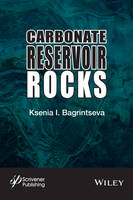Field Description of Metamorphic Rocks
 -15%
portes grátis
-15%
portes grátis
Field Description of Metamorphic Rocks
Caddick, Mark; Jerram, Dougal
John Wiley and Sons Ltd
03/2022
192
Mole
Inglês
9781118618752
15 a 20 dias
242
Descrição não disponível.
Preface vii
Acknowledgments ix
1 Introduction and Occurrence 1
1.1 The Importance of Fieldwork in Metamorphic Terrains 1
1.2 Understanding Metamorphism; Pressure/Temperature Relationships 4
1.3 Mode of Occurrence of Metamorphic Bodies 4
1.4 Summary 13
2 Field Skills and Mapping Outcrop Structures 17
2.1 Equipment 17
2.2 Preparing Maps and Basic Mapping 19
2.3 Notebooks and Data Recording 20
2.4 Digital 3D Outcrop Mapping 33
3 Metamorphic Minerals, Rock Types, and Classification 37
3.1 Minerals 37
3.2 The Basic Classification of Metamorphic Rocks in P-T 46
3.3 Metamorphic Rock Names 48
3.4 Reporting Rock Types 50
3.5 Compositional Category and Metamorphic Grade 54
4 Understanding Textures and Fabrics 1: Banding, Cleavage, Schistosity, and Lineations 67
4.1 General Terminology 67
4.2 Rocks without a Metamorphic Directional Fabric 71
4.3 Banding 71
4.4 The Development of Fabric, Cleavage, Schistosity, and Lineations 79
4.5 Refraction, Kinking, and Shearing of Fabrics 88
4.6 Deformation Fabrics and Folds 89
5 Understanding Textures and Fabrics 2: Metamorphic Crystals, Pseudomorphs, and Scattered Entities 95
5.1 Recording Metamorphic Textures 95
5.2 Metamorphic Crystal Growth and Porphyroblasts 97
5.3 Boudins, Shear Pods, and Knockers 109
6 Contacts, Reaction Zones, and Veins 115
6.1 Igneous Contacts - Aureoles and Metasomatism 115
6.2 Veins and Pegmatites 124
6.3 Reaction Zones and Chemical Changes at Contacts 130
7 Faults, Mylonites, and Cataclasites 137
7.1 Fault and Shear Zone Types 137
7.2 Faults and Fault Breccias 138
7.3 Cataclasites and Pseudotachylites 141
7.4 Mylonites and Shear Zones 144
8 Summary Tables, Checklists, and Mapping Report Advice 151
8.1 Compositional Categories and Their Grade Indicators 151
8.2 Minerals 157
8.3 Further Mapping Advice; Formations, Markers, and a Final Report 164
Checklist of Rock Features 171
Further Reading Suggestions 173
Index 175
Acknowledgments ix
1 Introduction and Occurrence 1
1.1 The Importance of Fieldwork in Metamorphic Terrains 1
1.2 Understanding Metamorphism; Pressure/Temperature Relationships 4
1.3 Mode of Occurrence of Metamorphic Bodies 4
1.4 Summary 13
2 Field Skills and Mapping Outcrop Structures 17
2.1 Equipment 17
2.2 Preparing Maps and Basic Mapping 19
2.3 Notebooks and Data Recording 20
2.4 Digital 3D Outcrop Mapping 33
3 Metamorphic Minerals, Rock Types, and Classification 37
3.1 Minerals 37
3.2 The Basic Classification of Metamorphic Rocks in P-T 46
3.3 Metamorphic Rock Names 48
3.4 Reporting Rock Types 50
3.5 Compositional Category and Metamorphic Grade 54
4 Understanding Textures and Fabrics 1: Banding, Cleavage, Schistosity, and Lineations 67
4.1 General Terminology 67
4.2 Rocks without a Metamorphic Directional Fabric 71
4.3 Banding 71
4.4 The Development of Fabric, Cleavage, Schistosity, and Lineations 79
4.5 Refraction, Kinking, and Shearing of Fabrics 88
4.6 Deformation Fabrics and Folds 89
5 Understanding Textures and Fabrics 2: Metamorphic Crystals, Pseudomorphs, and Scattered Entities 95
5.1 Recording Metamorphic Textures 95
5.2 Metamorphic Crystal Growth and Porphyroblasts 97
5.3 Boudins, Shear Pods, and Knockers 109
6 Contacts, Reaction Zones, and Veins 115
6.1 Igneous Contacts - Aureoles and Metasomatism 115
6.2 Veins and Pegmatites 124
6.3 Reaction Zones and Chemical Changes at Contacts 130
7 Faults, Mylonites, and Cataclasites 137
7.1 Fault and Shear Zone Types 137
7.2 Faults and Fault Breccias 138
7.3 Cataclasites and Pseudotachylites 141
7.4 Mylonites and Shear Zones 144
8 Summary Tables, Checklists, and Mapping Report Advice 151
8.1 Compositional Categories and Their Grade Indicators 151
8.2 Minerals 157
8.3 Further Mapping Advice; Formations, Markers, and a Final Report 164
Checklist of Rock Features 171
Further Reading Suggestions 173
Index 175
Este título pertence ao(s) assunto(s) indicados(s). Para ver outros títulos clique no assunto desejado.
Preface vii
Acknowledgments ix
1 Introduction and Occurrence 1
1.1 The Importance of Fieldwork in Metamorphic Terrains 1
1.2 Understanding Metamorphism; Pressure/Temperature Relationships 4
1.3 Mode of Occurrence of Metamorphic Bodies 4
1.4 Summary 13
2 Field Skills and Mapping Outcrop Structures 17
2.1 Equipment 17
2.2 Preparing Maps and Basic Mapping 19
2.3 Notebooks and Data Recording 20
2.4 Digital 3D Outcrop Mapping 33
3 Metamorphic Minerals, Rock Types, and Classification 37
3.1 Minerals 37
3.2 The Basic Classification of Metamorphic Rocks in P-T 46
3.3 Metamorphic Rock Names 48
3.4 Reporting Rock Types 50
3.5 Compositional Category and Metamorphic Grade 54
4 Understanding Textures and Fabrics 1: Banding, Cleavage, Schistosity, and Lineations 67
4.1 General Terminology 67
4.2 Rocks without a Metamorphic Directional Fabric 71
4.3 Banding 71
4.4 The Development of Fabric, Cleavage, Schistosity, and Lineations 79
4.5 Refraction, Kinking, and Shearing of Fabrics 88
4.6 Deformation Fabrics and Folds 89
5 Understanding Textures and Fabrics 2: Metamorphic Crystals, Pseudomorphs, and Scattered Entities 95
5.1 Recording Metamorphic Textures 95
5.2 Metamorphic Crystal Growth and Porphyroblasts 97
5.3 Boudins, Shear Pods, and Knockers 109
6 Contacts, Reaction Zones, and Veins 115
6.1 Igneous Contacts - Aureoles and Metasomatism 115
6.2 Veins and Pegmatites 124
6.3 Reaction Zones and Chemical Changes at Contacts 130
7 Faults, Mylonites, and Cataclasites 137
7.1 Fault and Shear Zone Types 137
7.2 Faults and Fault Breccias 138
7.3 Cataclasites and Pseudotachylites 141
7.4 Mylonites and Shear Zones 144
8 Summary Tables, Checklists, and Mapping Report Advice 151
8.1 Compositional Categories and Their Grade Indicators 151
8.2 Minerals 157
8.3 Further Mapping Advice; Formations, Markers, and a Final Report 164
Checklist of Rock Features 171
Further Reading Suggestions 173
Index 175
Acknowledgments ix
1 Introduction and Occurrence 1
1.1 The Importance of Fieldwork in Metamorphic Terrains 1
1.2 Understanding Metamorphism; Pressure/Temperature Relationships 4
1.3 Mode of Occurrence of Metamorphic Bodies 4
1.4 Summary 13
2 Field Skills and Mapping Outcrop Structures 17
2.1 Equipment 17
2.2 Preparing Maps and Basic Mapping 19
2.3 Notebooks and Data Recording 20
2.4 Digital 3D Outcrop Mapping 33
3 Metamorphic Minerals, Rock Types, and Classification 37
3.1 Minerals 37
3.2 The Basic Classification of Metamorphic Rocks in P-T 46
3.3 Metamorphic Rock Names 48
3.4 Reporting Rock Types 50
3.5 Compositional Category and Metamorphic Grade 54
4 Understanding Textures and Fabrics 1: Banding, Cleavage, Schistosity, and Lineations 67
4.1 General Terminology 67
4.2 Rocks without a Metamorphic Directional Fabric 71
4.3 Banding 71
4.4 The Development of Fabric, Cleavage, Schistosity, and Lineations 79
4.5 Refraction, Kinking, and Shearing of Fabrics 88
4.6 Deformation Fabrics and Folds 89
5 Understanding Textures and Fabrics 2: Metamorphic Crystals, Pseudomorphs, and Scattered Entities 95
5.1 Recording Metamorphic Textures 95
5.2 Metamorphic Crystal Growth and Porphyroblasts 97
5.3 Boudins, Shear Pods, and Knockers 109
6 Contacts, Reaction Zones, and Veins 115
6.1 Igneous Contacts - Aureoles and Metasomatism 115
6.2 Veins and Pegmatites 124
6.3 Reaction Zones and Chemical Changes at Contacts 130
7 Faults, Mylonites, and Cataclasites 137
7.1 Fault and Shear Zone Types 137
7.2 Faults and Fault Breccias 138
7.3 Cataclasites and Pseudotachylites 141
7.4 Mylonites and Shear Zones 144
8 Summary Tables, Checklists, and Mapping Report Advice 151
8.1 Compositional Categories and Their Grade Indicators 151
8.2 Minerals 157
8.3 Further Mapping Advice; Formations, Markers, and a Final Report 164
Checklist of Rock Features 171
Further Reading Suggestions 173
Index 175
Este título pertence ao(s) assunto(s) indicados(s). Para ver outros títulos clique no assunto desejado.





